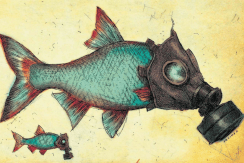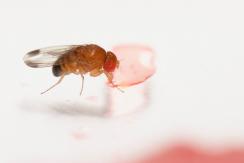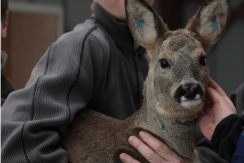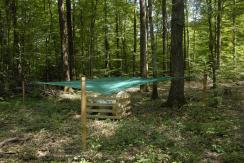Evolutionary Ecology
The department of Evolutionary Ecology gathers complementary skills in behavioural ecology, population dynamics, population biology, community ecology, and methodology (statistics and modelling). The research done in the department aims at studying how animal species evolve in a changing world by understanding the causes of the evolution of traits, adaptations and interactions. For that, we consider different levels of organization from individuals to populations and communities. Because organisms cannot be considered isolated from other biotic factors, we consider pathogens but also competing species within communities.
We study how individuals adapt to their environments that are largely impacted by anthropic pressures, and how life history traits and behaviour evolve in response to these pressures. Although we mainly focus on phenotype, we more and more consider the mechanistic link between the genotype and the phenotype. We develop the theoretical framework of our discipline through a conceptual and modeling approach. In parallel, we test hypotheses that arise from theoretical predictions through experimental, comparative and observational approaches on different biological models (insects, birds, mammals). Experimental approaches are developed in the laboratory (insect model) and in natura (bird, insect and mammal models). Observational and comparative research is mainly concerned with vertebrates. Our approaches are also, and increasingly, interested in the mechanisms of adaptive responses. In addition to the classical approaches of demographic analysis and trait change, methods of ecophysiology, chemical ecology and molecular biology are used.
Our department hosts several long-term studies of wild populations of different species. These long-term studies offer a valuable way to understand how biotic and abiotic factors affect individuals’ life history traits, and the functioning of populations in natura. Five populations of mammalian species are thus monitored for several years (more than 40 years on roe deer, 30 on Alpine marmots, 25 years on cats, 16 years on zebras, and 20 years on impala). Two of our study sites (La Sassière in Vanoise National Park (Alpine marmots) and Hwange National Park) have been certified as “Site d’Etude en Ecologie Globale” (SEEG), and two (ZA “Hwange” and ZA “Antarctic and sub-Antarctic”) were certified as “Zone Atelier” by the CNRS.
The department of Evolutionary ecology is also largely involved in training activities. Lastly, we also have strong socio-economic relationships. Indeed, because we address questions of major societal interest (global warming, public health) we tightly collaborate with socio-economic partners (Office Français de la Biodiversité, Vanoise National Park, Hwange National Park in Zimbabwe, Office National des Forêts, etc.) and participate to general public and media events.
Publications
Display of 1381 to 1410 publications on 2449 in total
The relationship between phenotypic variation among offspring and mother body mass in wild boar: evidence of coin-flipping?
Journal of Animal Ecology . 82 ( 5 ) : 937-945
Journal article
see the publicationThe relationship between phenotypic variation among offspring and mother body mass in wild boar: evidence of coin-flipping?
Journal of Animal Ecology . 82 ( 5 ) : 937--945
Journal article
see the publicationFluctuating food resources influence developmental plasticity in wild boar
Biology Letters . 9 ( 5 ) : 20130419
Journal article
see the publicationPolyandry Has No Detectable Mortality Cost in Female Mammals
PLoS ONE . 8 : e66670
Journal article
see the publicationSenescence in natural populations of animals: Widespread evidence and its implications for bio-gerontology
Ageing Research Reviews - ARR . 12 : 214--25
Journal article
see the publicationHow life history influences population dynamics in fluctuating environments.
The American Naturalist . 182 ( 6 ) : 743-759
DOI: 10.1086/673497
Journal article
see the publicationMale survival patterns do not depend on male allocation to sexual competition in large herbivores
Behavioral Ecology . 24 : 421--428
Journal article
see the publicationAlpine ibex males grow large horns at no survival cost for most of their lifetime
Oecologia . 173 : 1261--9
Journal article
see the publicationDecreasing litter size of marmots over time: a life history response to climate change?
Ecology . 94 : 580--586
Journal article
see the publicationVariation in adult body mass of roe deer: early environmental conditions influence early and late body growth of females
Ecology . 94 ( 8 ) : 1805-1814
DOI: 10.1890/13-0034.1
Journal article
see the publicationThe role of epistasis in protein evolution
Nature . 497 : E1--E2
DOI: 10.1038/nature12219
Journal article
see the publicationVector-Borne Diseases in the light of Evolutionary Ecology : example of Chagas disease
Vector-Borne Disease : a multidisciplany approach .
Conference paper
see the publicationEnvironmental determinants of spatial and temporal variations in the transmission of Toxoplasma gondii in its definitive hosts.
International Journal for Parasitology: Parasites and Wildlife . 2 : 278-85
Journal article
see the publicationMolecular variation and chromosomal stability within Gerbillus nanus (Rodentia, Gerbillinae): taxonomic and biogeographic implications
Mammalia . 77 : 105--111
Journal article
see the publicationRoles of dental development and adaptation in rodent evolution
Nature Communications . 4 ( 1 )
DOI: 10.1038/ncomms3504
Journal article
see the publicationInvasive house mice facing a changing environment on the Sub-Antarctic Guillou Island (Kerguelen Archipelago)
Journal of Evolutionary Biology . 26 : 612--24
DOI: 10.1111/jeb.12079
Journal article
see the publicationComparing parent-offspring regression with frequentist and Bayesian animal models to estimate heritability in wild populations: a simulation study for Gaussian and binary traits
Methods in Ecology and Evolution . 4 : 260-275
Journal article
see the publicationA guide for using functional diversity indices to reveal changes in assembly processes along ecological gradients
Journal of Vegetation Science . 24 : 794--806
DOI: 10.1111/jvs.12013
Journal article
see the publicationFitness consequences of northward dispersal as possible adaptation to climate change, using experimental translocation of a migratory passerine
PLoS ONE . 8 : e83176
Journal article
see the publicationExperimental infection of pregnant Pyrenean chamois (Rupicapra pyrenaica) with border disease virus subtype 4.
Journal of wildlife diseases . 49 ( 1 ) : 55-68
DOI: 10.7589/2011-09-260
Journal article
see the publicationResistance of Drosophila suzukii to the larval parasitoids Leptopilina heterotoma and Asobara japonica is related to haemocyte load
Physiological Entomology . 38 ( 1 ) : 45 - 53
DOI: 10.1111/phen.12002
Journal article
see the publicationAssessing fitness consequences of migratory tactics requires long-term individually based monitoring
Ecology . 94 : 1261-1264
Journal article
see the publicationLife-history phenology strongly influences population vulnerability to toxicants: a case study with the mudsnail Potamopyrgus antipodarum.
Environmental Toxicology and Chemistry . 32 ( 8 ) : 1727-36
DOI: 10.1002/etc.2235
Journal article
see the publicationEcologie prédictive & changement planétaire
Prospective de l'Institut écologie & environnement du CNRS . hors s\'{e}rie : 9-44
Book chapter
see the publicationEndosymbiont diversity among sibling weevil species competing for the same resource
BMC Evolutionary Biology . 13 : 28
Journal article
see the publicationDoes cold tolerance plasticity correlate with the thermal environment and metabolic profiles of a parasitoid wasp ?
Comparative Biochemistry and Physiology - Part A: Molecular and Integrative Physiology . 164 : 77-83
Journal article
see the publicationDiversification of the eutherian placenta is associated with changes in the pace of life
Proceedings of the National Academy of Sciences of the United States of America . 110 : 7760-7765
Journal article
see the publicationRoaring counts are not suitable for the monitoring of red deer Cervus elaphus population abundance
Wildlife Biology . 19 : 94-101
DOI: 10.2981/12-037
Journal article
see the publicationComparing free-ranging and captive populations reveals intra-specific variation in aging rates in large herbivores
Experimental Gerontology . 48 : 162--7
Journal article
see the publicationSex-specific senescence in body mass of a monogamous and monomorphic mammal: the case of Alpine marmots
Oecologia . 172 : 427--36
Journal article
see the publication





You also, comment on this article